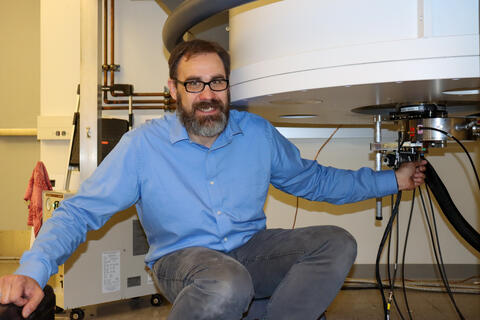
Whether it’s a small or large molecule that needs characterizing, Yale’s Chemical and Biophysical Instrumentation Center (CBIC) has a device for that. The Center houses over 40 instruments for some 300 registered users from across Yale and Connecticut to analyze samples for their research.
Eric Paulson ‘04 Ph.D., an alumnus of the Chemistry Department who studied physical chemistry, has been the director of the CBIC for the past 12 years. He leads a team of four expertly trained staff who help researchers solve scientific problems.
We met with Paulson among the giant, noisy equipment in the Chemistry Research Building to learn about the Center, including its contribution to COVID-19 research.
What goes on at the Center?
We oversee an extensive collection of scientific instruments open to any researcher with a need for them. We train people to operate them, understand data, and figure out what new data is needed to get an answer. People can also give us samples, and we will collect data using our instruments.
What type of instruments are we talking about?
The three pillars of the CBIC are NMR or nuclear magnetic resonance spectroscopy – which is my area of expertise – mass spectrometry, and X-ray. We have at least one Ph.D.-level staff person who oversees each area.
We also have instruments that don’t fall into these categories.
What does the Center offer researchers?
We offer training, education, and service. We are lucky we have one of the best NMR facilities in the country, with more NMR instruments (12) than a typical chemistry department.
How would you explain NMR to a layperson?
Most people have heard of an MRI. Both MRI and NMR are magnetic resonance techniques. In the first case, you make an image, and in the second, you collect a spectrum.
For NMR, we see peaks at different frequencies of radio waves in a spectrum. These peaks are correlated to the structures of the molecules in a sample. It’s one of the most powerful ways to identify, confirm, or determine the structure of a molecule.
Which chemists are more likely to use NMR?
It’s one of the primary techniques used by synthetic chemists. They often use NMR as a primary way of monitoring what they’ve done. They might be running samples by NMR as many as a dozen times in a day. So that’s one reason we have a lot of NMR instruments.
How did things change for you guys during the pandemic?
We never shut down completely. One reason is that some of our equipment needs regular maintenance or, essentially, it will self-destruct.
We came up with a schedule where each of us would come in and work on a different day of the week.
Almost all science shut down, but one of the things that was continuing was anything related to COVID. We were fortunate to help an outside company working on a potential therapy for COVID-19.
In June 2020, the whole department reopened in a very careful way, and students did shift work. We spread out our instruments into unoccupied rooms around the department for social distancing.
What aspect of your job do you like the most?
One of the most enjoyable aspects of what we do is collaborate with the grad students and faculty to solve the problems they’re up against. It’s not just cranking out the data, but often it’s a more collaborative approach, and I think that’s what probably drives all of us in the CBIC.
Learn more about the Yale Chemical and Biophysical Instrumentation Center.